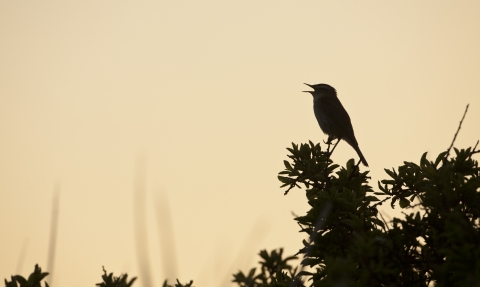
A bird at dawn chorus © Mark Hamblin/2020VISION
The Early Bird...
One of the most iconic nature spectacles in spring is the famed dawn chorus, an early-morning symphony of birds trying to attract a mate. Here are some of our warblers to listen out for:
© Gavin Vella via YouTube
Chiffchaff
The chiffchaff is one of the first warblers to sing in spring. His tune is simple - he keeps chanting his own name.
Blackcap
As a scrub dweller, you're more likely to hear than to see the blackcap. He arrives shortly after the chiffchaff and can be identified by his distinctive black cap (males).
© Gavin Vella via YouTube
Sedge warbler
Sedge warblers inhabit reed and sedge beds around wetlands. Their song is rather scratchy. If you catch a glimpse, look out for a light eye stripe, known as a supercilium.
© Gavin Vella via YouTube
Reed warbler
The reed warbler's song is croaky and continuous - it sounds like it doesn't stop to breathe at all (birds can sing while breathing!). You can find it in reed beds around wetlands.
© Gavin Vella via YouTube
Willow warbler
Willow warblers are less common in our area. It looks similar to the chiffchaff, but you'll hear the difference in the song!
© Gavin Vella via YouTube
Grasshopper warbler
The distinctive grasshopper warbler really lives up to its name: found on some of our wetland reserves, its song really sounds like the stridulations of a grasshopper.
© Gavin Vella via YouTube
Whitethroat
Just like the blackcap, the whitethroat is a scrub dweller that you're more likely to hear than to see. The common whitethroat has a bright white throat whereas the lesser whitethroat has a pale white throat.
© Gavin Vella via YouTube
Garden warbler
Contrary to its name, the garden warbler doesn't actually live in our gardens but in woodlands. Their plumage is mostly grey with no distinctive features - but looks aren't everything and the garden warbler makes up for it with a lovely bubbly song.
